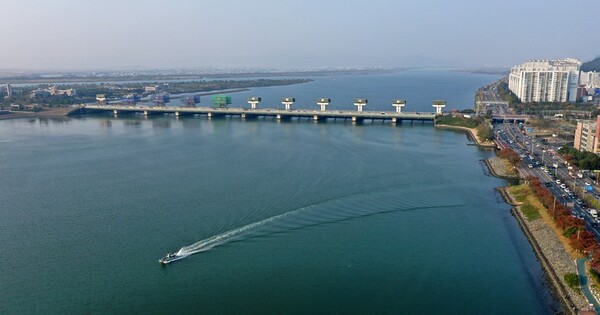Nakdong River estuary bank is the first step to restoring the ecosystem in 35 years.
The estuary bank that divided Nakdong River and the sea for 35 years will finally re-open and seek to be the solution of ecosystem restoration.

The Busan City government recently reported one floodgate among 10 that was built on the estuary bank in Nakdong River is being kept open throughout the year and so on.
Opening the floodgate will be the first step to restoring the ecosystem of nearby areas. The potential of environmental recovery from opening the floodgate will be verified through the demonstration in Nakdong River Estuary Bank, which was started in 2019. According to the Ministry of Environment, one floodgate was opened to demonstrate and monitor. Researchers observed eel, sea bass, mullet, and other freshwater fish returning without any other salt damage. As a result, subsections of the brackish water ecosystem were restored.
The ecosystem restoration project in the estuary bank is expected to have progress with the opening of the Nakdong River Estuary Bank. In advance, the Water of Nakdong River Basin Commission Support Department voted on “a measure to restore the brackish water ecosystem in Nakdong River estuary” on February 9th. The Ministry of Environment will observe water quality and ecological changes via creating a water station only 15km from the estuary to the upper stream for the supply of agricultural, industrial, and residential water and will stop the inflow of seawater to prevent salt damage when the salt reaches 10km to 12km from the estuary to the upper stream.
Jeon Byung-Gyu (Assistant manager, Korea Water Resources Corporation) said, “The migratory fish species, like eels, were discovered through the last demonstration. We should continuously monitor the ecosystem, but we are expected to effect the recovery of the brackish water ecosystem in the long term. At the same time, we promoted the restoration of scirpus planiculmis, a prey of whistling swans last year. If we push ahead with this, winter visitors will steadily rise due to the increase of food sources".
Nakdong River Estuary is a treasure chest of the ecosystem and a habitat for migratory birds in the country that has biodiversity. However, fish species have become indiverse and vegetations have changed, and therefore, migratory birds have reduced after the estuary bank was established in 1987. Approximately, a million of the migratory birds that returned to Eulsukdo Island every year decreased five to ten percent since 1990. Corbiculas and eels, a specialty in Busan, gradually disappeared and reeds have reduced. Salmons that went upstream from sea to river were blocked by the estuary bank and the stagnated river lead to the proliferation of green algae.
Reporter Shin Yu-Jun
Translated by Park Yeon-Hee

